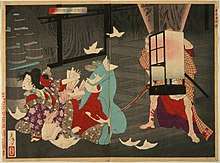Tsujigiri
Tsujigiri (辻斬り or 辻斬, literally "crossroads killing") is a Japanese term for a practice when a samurai, after receiving a new katana or developing a new fighting style or weapon, tests its effectiveness by attacking a human opponent, usually a random defenseless passer-by, in many cases during nighttime.[1] The practitioners themselves are also referred to as tsujigiri.[1]
Variations
Sword attacks were not the only possible application of this act. In a variation named tsuji-nage (辻投げ, "crossroads throwing"), the samurai would attack the passerby with jujutsu in order to test his own techniques or indulge in alive practice.[2] This must not be mistaken with tsuji-zumo, unsanctioned sumo bouts hosted in the street between willing participants.
History
In the medieval era, the term referred to traditional duels between samurai, but in the Sengoku period (1467–1600), widespread lawlessness caused it to degrade into indiscriminate murder, permitted by the unchecked power of the samurai. Shortly after order was restored, the Edo government prohibited the practice in 1602. Offenders would receive capital punishment.[1]
1696 spree killing
| 1696 Yoshiwara spree killing | |
|---|---|
 Tsukioka Yoshitoshi’s Sano Jirōzaemon Murdering a Courtesan (1886) | |
| Location | Yoshiwara, Edo, Tokugawa shogunate (Japan) |
| Date | December 1696 |
| Weapons | Katana |
| Deaths | 100+ |
| Perpetrator | Sano Jirōzaemon |
The only known incident where a very large number of people were indiscriminately killed in the Edo period was the 1696 Yoshiwara spree killing (吉原百人斬り, Yoshiwara hyakunin giri; "One hundred Yoshiwara slash"), where a wealthy lord, Sano Jirōzaemon, had a psychotic fit and murdered dozens of prostitutes with a katana in Yoshiwara, the red-light district of Edo (modern-day Tokyo). Over 100 were killed in the attacks and the following process of apprehension. Despite his class and heritage, he was treated by authorities as a spree killer and was later sentenced to death and executed.[3] Later, a kabuki play was made about the incident; the incident later inspired the 1960 movie adaptation Hero of the Red-Light District.[4] 50-year-old Tokugawa Tsunayoshi, the 5th Shōgun of the Tokugawa shogunate, was serving his 16th year in power at the time of the attack.
It remains the worst massacre committed by a single perpetrator in Japanese history.
See also
References
- つじぎり 【辻斬り】 国語辞書 - エキサイト辞書. Excite.co.jp. Retrieved 22009-31-12.
- Rajender Singh, Fundamentals of Judo
- Roadside Samurai: The Brutal act of Tsujigiri
- Mitamura, Engyo. Edo banashi shūsei. Vol. 1. 1956.